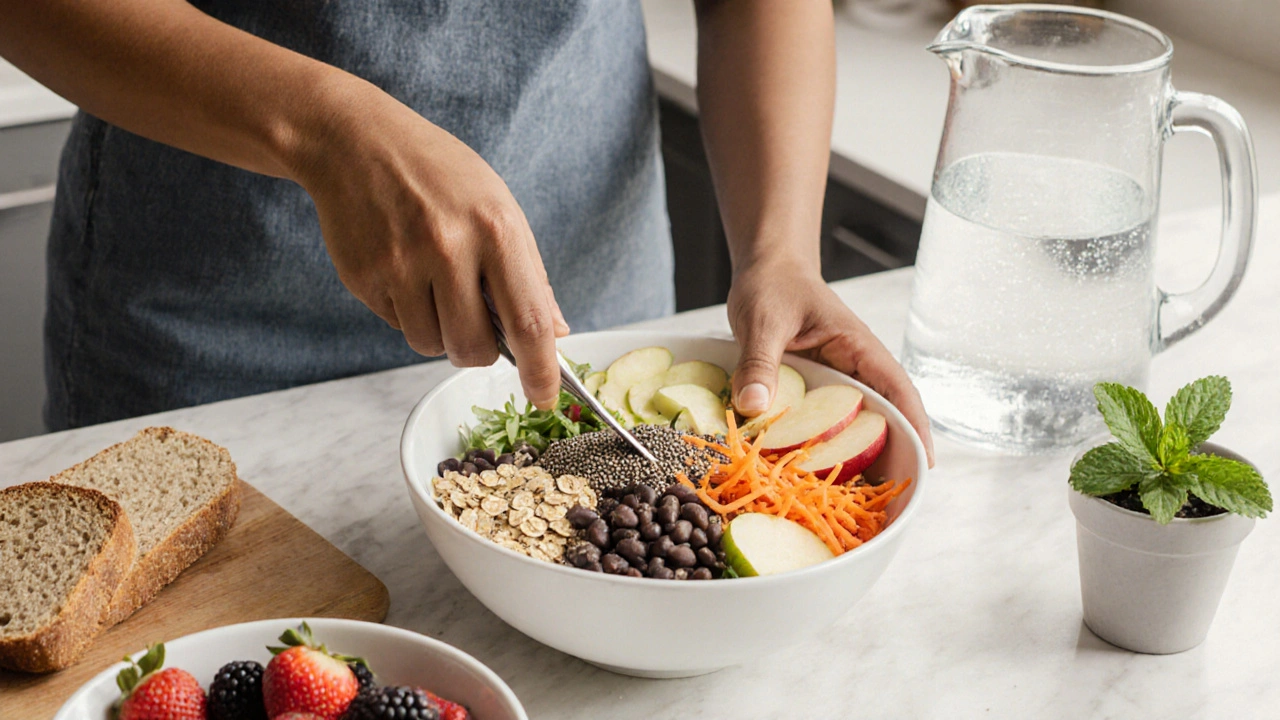

When you hear about soluble fiber, a type of dietary fiber that dissolves in water and forms a gel‑like substance in the digestive tract. Also known as viscous fiber, it helps slow nutrient absorption and supports overall health. Dietary fiber, the umbrella term for soluble and insoluble fibers found in plant foods includes both, but soluble fiber plays a unique role in gut health, the balance of microbes and the function of the gastrointestinal system. It also influences cholesterol, the blood lipids that, when elevated, raise heart disease risk and helps regulate blood sugar, the level of glucose circulating in the bloodstream after meals. In short, soluble fiber is a key player in several health pathways.
First, soluble fiber lowers cholesterol by binding bile acids in the gut. Bile acids are made from cholesterol, so when they’re trapped in the fiber gel and expelled, the liver pulls more cholesterol from the blood to make new bile, effectively reducing LDL levels. Second, the gel slows the breakdown of carbohydrates, which blunts the post‑meal glucose spike and improves insulin sensitivity. This is why people with pre‑diabetes or type 2 diabetes often see better glucose control when they add more soluble fiber to meals. Third, the fermentable portion feeds beneficial gut bacteria, producing short‑chain fatty acids that nurture colon cells and reduce inflammation.
These three effects—cholesterol reduction, blood‑sugar moderation, and gut‑microbe support—are interconnected. For example, a healthier microbiome can improve lipid metabolism, while steadier blood sugar lessens the inflammatory load that drives heart disease. Understanding this web makes it clear why nutrition experts rank soluble fiber as a cornerstone of a cardioprotective and metabolic‑friendly diet.
So, what foods pack the most soluble fiber? Oats, barley, beans, lentils, apples, citrus fruits, carrots, and psyllium husk are the usual suspects. The amount varies: a half‑cup of cooked oats supplies about 1 gram, while a tablespoon of psyllium can give you 3‑4 grams. The daily recommendation for total fiber is about 25 grams for women and 38 grams for men, with at least 5‑10 grams coming from the soluble side. Hitting those numbers doesn’t require a drastic overhaul; swapping white rice for barley in a stir‑fry or topping yogurt with sliced apple adds a quick boost.
If you’re not a fan of whole grains or fruit, supplements like psyllium powder or inulin can fill the gap. Just remember that fiber works best with plenty of water—without it, you risk constipation instead of relief. Start with a small dose, gradually increase, and drink an extra glass with each serving.
Another practical tip: incorporate soluble fiber into every meal. Breakfast oatmeal or a smoothie with chia seeds sets the tone. Lunch can feature a bean‑based soup or a salad topped with orange segments. Dinner might include a side of roasted carrots or a quinoa‑and‑barley blend. Even desserts can help—baked apples with cinnamon or a fruit‑rich parfait add flavor and fiber without extra sugar.
While the benefits are clear, there are a few cautions. People with certain gastrointestinal conditions, such as IBS with predominant diarrhea, may find high soluble fiber irritating at first. In those cases, a low‑FODMAP approach—choosing oats and strawberries over beans and apples—can ease symptoms. Also, if you’re on cholesterol‑lowering meds like statins, discuss fiber intake with your doctor; the combined effect is usually safe but monitoring is wise.
Beyond personal health, soluble fiber has a public‑health angle. Diets rich in fiber are linked to lower rates of heart disease, stroke, and some cancers. Communities that promote whole‑grain and legume consumption often see reduced healthcare costs related to chronic diseases. This broader impact reinforces why nutrition guidelines around the world highlight fiber as a daily priority.
In terms of research, a 2023 meta‑analysis of 30 trials found that adding 5‑10 grams of soluble fiber per day reduced LDL cholesterol by an average of 5 mg/dL and lowered fasting blood glucose by 4 mg/dL. Another study showed that participants who consumed a soluble‑fiber‑rich diet experienced a 12 % reduction in appetite scores, likely because the gel slows gastric emptying and promotes satiety.
Putting all this together, the picture is simple: soluble fiber is a versatile, evidence‑backed nutrient that supports heart health, blood‑sugar control, and gut balance. Whether you reach for a bowl of oatmeal, a lentil soup, or a spoonful of psyllium, you’re adding a functional ingredient that works on multiple fronts. The next sections of this page list articles that dive deeper into specific topics like fiber’s role in cholesterol management, gut microbiome science, and practical cooking tips.
Ready to explore more? Below you’ll find a curated collection of posts that break down the science, compare fiber‑rich foods, and give you step‑by‑step guides to boost your intake safely and deliciously.

Learn how soluble fiber can tame chronic diarrhea, which foods boost the right fiber, which to avoid, and practical tips for a balanced diet.